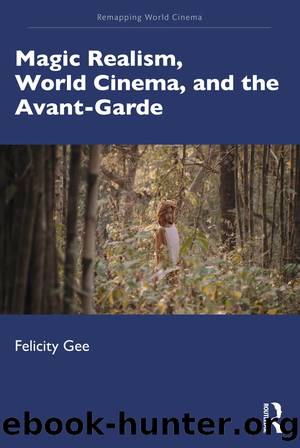Magic Realism, World Cinema, and the Avant-Garde by Felicity Gee

Author:Felicity Gee [Gee, Felicity]
Language: eng
Format: epub
Tags: History, Modern, 20th Century, Performing Arts, Film, General, Social Science, Media Studies
ISBN: 9781315312798
Google: frQgEAAAQBAJ
Publisher: Routledge
Published: 2021-04-19T04:13:36+00:00
A marvellous revelation: âFor the full experience of wonder [â¦] The object must be unexpectedly, instantaneously seen for the first timeâ (Fisher 1998, p.17). This literal eruption readies him for what is to follow, but it is only possible because his vantage point is from an aeroplane â enabling a manipulation of view that would be very much at home in Foto-Auge â the Orinoco yields to this gaze, despite its power to dominate the earth. This is the paradox of Carpenterian discourse. In the Fundación Alejo Carpentier archive is a large photo album labelled in gold âEscenario De Los Pasos Perdidos De Alejo Carpentierâ, which contains 28 black and white photographs of his voyage on the Orinoco River (I have no idea whether Power ever received the negatives he desired). This fascinating object provides a marvellous link between the novel, the physical, and the mental quest into la selva. As one would expect from having read the novel, the photographs detail the force of the natural habitat â river, mountains, and plateaus â âDos de las Más Singulares Mesetas De La Gran Sabanaâ â the jungle and its tangled trees, and âthe highest waterfall in the worldâ â La CaÃda Del Angel â from ground and aerial perspectives. The habitat sustains people living in stone huts with thatched roofs, alongside the modern façade of a church with a hexagonal domed tower. The Indians appear in a number of the shots, dressed in loincloths, a young boy carrying a dead bird, and a portrait of Carpentier with Fray Diego De Valdearenas (the source for the novelâs Fray Pedro) captioned: âEl Padre Valdearnas Prefigura Un Personaje De Los Pasos Perdidosâ. Bright sunshine renders the tree trunks brilliant white, the high contrast creating striking and oblique juxtapositions within the landscape. The viewer sees Carpentier in a fishing boat on the river, just as we imagine the novelâs narrator looking for signs in the twisted roots of the banks, or Mexican artist Remedios Varoâs (1908â63) androgynous female explorer in Exploración de las Fuentes del rÃo Orinoco (Exploration of the Sources of the Orinoco, 1959), which seems to illustrate the central voyage of Carpentierâs novel. The figure, surrounded by tree trunks, floats in an amphibian boat, which is magically devised from a suit jacket and fishy gills. They stare with melancholy beyond the tree in the foreground, which opens into a small alcove where a three-legged table holds a small glass goblet fashioned as a fountain. Both Varo and Carpentier had travelled to Venezuela in 1948, a coincidence that has not been overlooked (Sanchez 2006). To consider these two works of art in one breath reveals the significance of the quest, for each was interested in dreams, the alchemical power of nature and the cosmos, and the traditions of oral and metaphysical histories. As with Carpentierâs descriptive prose, Varo seems to paint âwith her gazeâ capturing the immediate reality before her, forming a ârare poetry [â¦] enigmas [â¦] They are not mysterious paintings, they are marvelousâ (Paz cited in Lozano 2000, p.
Download
This site does not store any files on its server. We only index and link to content provided by other sites. Please contact the content providers to delete copyright contents if any and email us, we'll remove relevant links or contents immediately.
The Kite Runner by Khaled Hosseini(5085)
Gerald's Game by Stephen King(4584)
Dialogue by Robert McKee(4326)
The Perils of Being Moderately Famous by Soha Ali Khan(4171)
The 101 Dalmatians by Dodie Smith(3454)
Story: Substance, Structure, Style and the Principles of Screenwriting by Robert McKee(3399)
The Pixar Touch by David A. Price(3369)
Confessions of a Video Vixen by Karrine Steffans(3247)
How Music Works by David Byrne(3190)
Fantastic Beasts: The Crimes of Grindelwald by J. K. Rowling(2996)
Harry Potter 4 - Harry Potter and The Goblet of Fire by J.K.Rowling(2992)
Slugfest by Reed Tucker(2944)
The Mental Game of Writing: How to Overcome Obstacles, Stay Creative and Productive, and Free Your Mind for Success by James Scott Bell(2847)
4 - Harry Potter and the Goblet of Fire by J.K. Rowling(2657)
Screenplay: The Foundations of Screenwriting by Syd Field(2576)
The Complete H. P. Lovecraft Reader by H.P. Lovecraft(2514)
Scandals of Classic Hollywood: Sex, Deviance, and Drama from the Golden Age of American Cinema by Anne Helen Petersen(2467)
Wildflower by Drew Barrymore(2445)
Robin by Dave Itzkoff(2387)
